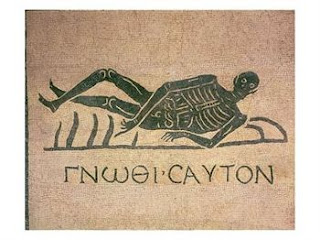But my experience of these images is a lot different. Let me go back in time a bit. I am a product of a late 20th c.
art school education. In my studio
classes I was required to discuss works in progress. These discussions with critics and other
types of instructors (mostly visual artists themselves) were verbal,
naturally. Duh!--that’s how people communicate…it would be pretty darned strange
if we’d done it via charades or smoke signals or anything other than spoken
language. The most common approach, for
those of you who didn’t go to art school is that the instructor, initiating the
critique says, “What are you working on?”…. What a question! I know, I know, it sounds so very, very
harmless! But how wrong you would
be!!!
The damage that tiny inquiry has
wrought...its no joke to say that alone has brought art to its knees…. A far more pernicious question, and one that
is so standard now as to be reflexively unquestioned is the one of
meaning. An artist is required to know,
a priori, what the work means. How that can even be in the age of POMO
(wherein the meaning might be said to arise from the context of the viewer, not
the mind of the maker), is pretty insane.
But regardless...there it is. ‘Tis
de rigeur in ths day and age when an artist is seen more as a manufacturer of
meaning than of objects or images.
Sigh…….
Why is it so bad?
Because after four years of interactions that are based on that model,
the student artist internalizes the injunction that, at the outset of their project, they should know what they are
doing. This leads to a culture in which
artists often know what they are making.
And uh oh—that’s NOT GOOD! At the
very least, its not very creative, as one would be engaging in the act of
re-creation (recreation) whatever it is they have in their noggin.
I could go on an on about how that innocent question inverts
the creative process so its exactly back wards—but the Cliff notes are that
perhaps, in artistic creativity, its is just fine to arrive at the answer after
the project is done. Or, dare I say it?
Maybe never? Let your fingers do
the walking and let the viewer do the interpreting.
All this is leading me to another aspect of my childhood,
wherein I dwelt on images I couldn’t figure out and this was good! Some of these images were Danish political
cartoons by Bo Bojensen. My parents had
three books of his, all in Danish. They
spoke tha language and I could have asked them to translate (and I did on
occasion) but better than that was to NOT KNOW.
And now, I arrive, finally at the point of this essay.
Being able to read is good.
Being able to read images is good too!
Duh! But also, there is great value in not knowing. I recently found out this is a Buddhist thing.
Knowing is comforting.
It allows us a sense of security and a feeling that there are certainties
and universal truths. “This is a chair,
it means I have a place to sit”…but as soon as something is assigned an
interpretation, alternatives are lost.
Inspiration is negated, exchanged for classification.
It seems to me, the end of an image is when you KNOW
it. I don’t want them to end…so I don’t
try to know them.
I love the fact that the images I post could have multiple
interpretations. When people suggest a
lot of potentialities, and there’s no one that seems superior to another, then
I know I have selected a fan-freaking-tastic image. An image that will live for a long, long
time, dancing around in human consciousness,
effervescing, evanescing and mutating and morphing and hop, skipping and
jumping around playing hide and go seek while we keep trying, keep seeking and
keep dancing in time with it. Yee ha….!


.jpg)






4 comments:
As a person teaching art at the college level for the past 15 years, I put much effort into pushing the pursuit you are speaking of. I talk to great lengths about how viewers can create meaning for work and for the artists, which we can neither know or see based on our limited personal experience. I can talk about why I made a particular piece after it's done or when the conception is completed, but like you, I prefer not knowing and just going from the gut. I also find the desire of some artists to control the viewers interpretations equally questionable. We can try, but the experience of a viewer will always bend our meaning to fit into their personal world view. Interesting things to think about.
As a side note, I am teaching a stained glass class for the first time at my new school, and your work has garnered the most fervent discussion and awe when I show slides of things I find interesting.
Hi Rick--
Thanks for the comments!!
I'm glad you feel the power of intuition is worhty!!!
xojudith
Judith:
Great essay. What Tony & I hear every time: What does it mean? At best, it means itself. It's why I so hate "artist's comments" at exhibitions. The art is the art. You've expressed it beautifully.
Keats describes what he terms 'Negative Capability' as the ability of operating "in uncertainties, mysteries, and doubtes without any irritable searching after fact and reason." The challenge of the artist is not only to create in this fashion- its the only way any thing vitally original comes into being, but also in so doing, model for the viewer this way of experiencing the world. Sort of like the ultimate in open mindedness.
Post a Comment